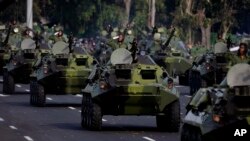In December of 2014, President Barack Obama and Cuban leader Raul Castro took the first steps towards ending decades of hostility and the last vestige of the Cold War struggle between the two countries.
Washington’s policy toward Cuba since the 1960s has been punctuated by economic embargoes, diplomatic isolation and covert efforts to undermine the Cuban government.
For its part, Havana never stepped back from its 1960s socialist policies after nationalizing all U.S.-owned businesses, including oil refineries, banks and telephone companies.
In a historic announcement Wednesday, Obama moved to reverse U.S. policy by easing travel, financial and other restrictions.
At the same time, in Havana, Castro announced the release of a number of political prisoners, and signaled his willingness to negotiate trade and other issues. The policy reversal followed a prisoner swap between the two countries.
Relations between the two countries first soured after Fidel Castro seized power in a revolution in 1959, causing then pro-Washington dictator President Fulgencio Batista to flee the country.
Castro swiftly began expropriating international business properties, farmland and land owned by foreigners.
Trade with Soviets
By the early 1960s, Fidel Castro started reaching out to the Soviet Union, reaching a number of trade deals. The United States, under President Dwight Eisenhower, reacted by placing embargoes on Cuban products.
Those decisions started decades of antipathy between the two countries, separated by only 145 kilometers (90 miles) of water.
By 1961, Washington had cut diplomatic relations with Havana, and desperate Cubans who were seeing their businesses and properties taken over by the communist government started trying to escape the country. Some 1 million Cubans left.
A failed CIA-led attempt to overthrow Cuba, known as the Bay of Pigs invasion, conducted with the approval of then-U.S. President John Kennedy, further deepened the mistrust between the two nations.
Relations reached an all-time low in 1962, when the U.S. discovered that the Soviet Union was planning to build a missile base on Cuba. The Cuban missile crisis ended with Moscow pledging to remove the missiles and Washington pledging not to invade Cuba and also to remove its missiles from Turkey.
Since the 1960s, successive U.S. presidents have maintained a crippling economic and diplomatic blockade on Cuba, driving more people out of the island nation. Fidel Castro, who stepped down in favor of his brother, Raul, in 2008, recently called for a "civilized" relationship with Washington.
The United Nations has repeatedly condemned the embargo.
The collapse of the Soviet Union in 1991 led to extreme economic hardship in Cuba but did not force a change in Fidel Castro's policies.
Relations between the two countries started to ease under Obama and Raul Castro.
Critics say Cuba still has a long way to go to end political repression.









